San Diego merece tener una economía y comunidades saludables.
Haga clic en la imagen de abajo para escuchar las historias de nuestro comunidad y aprende más sobre nuestro movimiento para conectar a San Diego..
La Environmental Helath Coalition (EHC) está dedicada a lograr la justicia ambiental y social. Creemos que la justicia se logra cuando las comunidades actúan juntas para lograr el cambio social. Organizamos y abogamos para proteger la salud pública y el medio ambiente amenazados por la contaminación tóxica. La EHC apoya amplios esfuerzos para crear una sociedad justa que fomente una calidad de vida saludable y sostenible.
Desde 1980 las campañas de base comunitaria de la EHC han enfrentado las injustas consecuencias de la contaminación tóxica, uso de suelo discriminatorio y políticas de energía no sostenible.
La EHC empodera a los residentes por medio del desarrollo de líderes, organización y abogacía, para lograr políticas públicas que mejoren la salud de los niños, familias y barrios, y al medio ambiente natural en la región de San Diego/Tijuana.
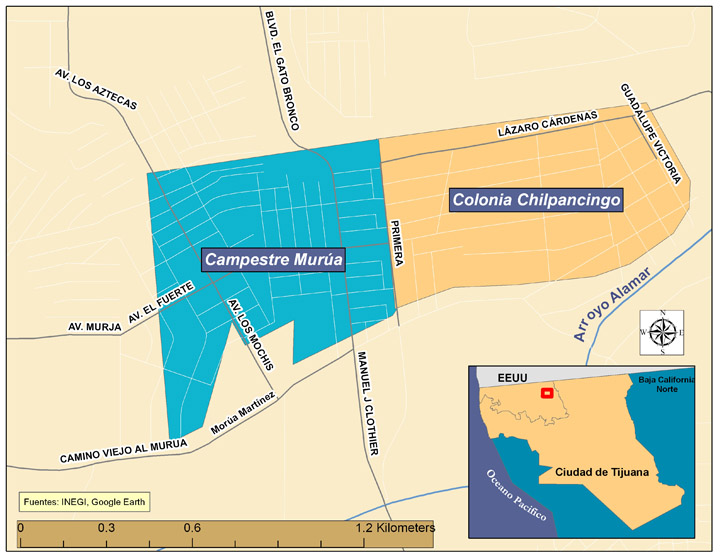
The communities of Colonia Chilpancingo, Colonia Murua and Nueva Esperanza share many of the problems found in San Diego's communities of color: substandard housing, over-crowded schools, a lack of social services, low-paid jobs, polluting industries mixed in with residential and commercial sites, industrial truck traffic, lack of parks and healthy food outlets, and severe air pollution. They are also adjacent to Tijuana's largest Maquiladora industrial complex.
EHC chose to work in these neighborhoods of Tijuana because their pollution problems skyrocketed after the passage of the North American Free Trade Agreement (NAFTA) in 1994 and the resulting growth of the maquiladora industry.
Although comprehensive economic and demographic data is not available for these neighborhoods, available data show that 67% of the homes have dirt floors, 66% do not have piped water, and 33% do not have sewer hook-ups. Two adults employed full-time in the maquiladora industry, the main source of employment, cover only two-thirds of the basic needs of a family of four.
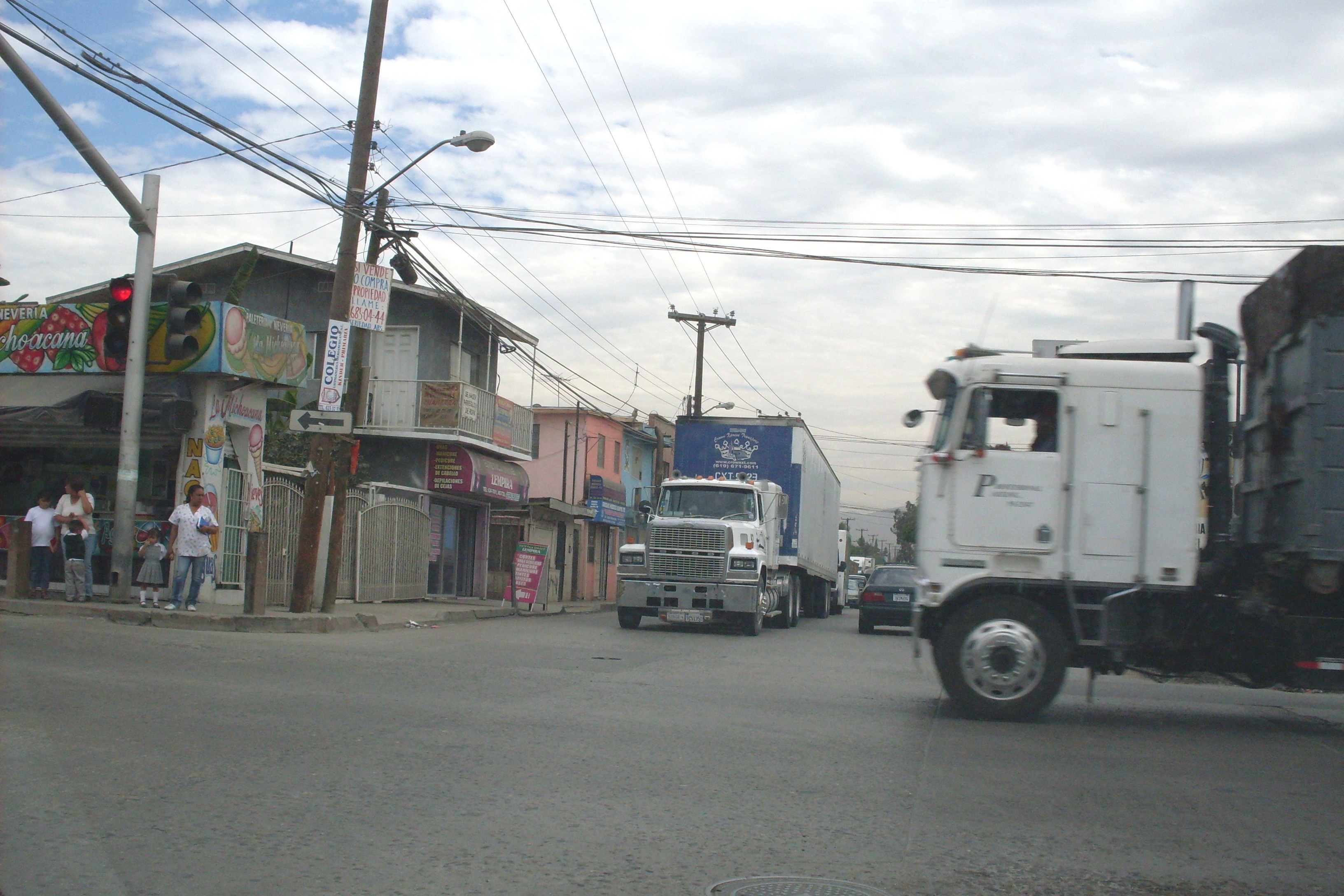
President Barack Obama appointed our executive director, Diane Takvorian, as a member of the Joint Public Advisory Committee to the CEC. Through this membership, she hopes to strengthen the tri-national commitment to environmental justice and bring the voice of the people to the front and center. She is currently working to strengthen the Citizens' Petition process.
Setup a PARA SIEMPRE giving plan to ensure your legacy and investment in creating healthy neighborhoods continues forever.
A bequest is one of the easiest gifts to make. With the help of an advisor, you can include language in your will or trust specifying a gift to be made to Environmental Health Coalition as part of your estate plan.
You can make a gift (bequest) to EHC through your will or living trust in the following ways:
*The information in this material is not intended as tax or legal advice. It may not be used for the purpose of avoiding any federal tax penalties or liabilities. Please consult your financial advisor to complete your donation.
Contact us: If you have any questions please contact our Fund Development Manager, Clay Myers-Bowman at (619) 474-0220 ext. 118 or by email: Esta dirección de correo electrónico está siendo protegida contra los robots de spam. Necesita tener JavaScript habilitado para poder verlo.
We would be happy to assist you and answer any questions you might have.
Have you ever considered donating your securities (i.e. stocks and mutual funds) as an alternative to cash? Donating appreciated securities – such as stock or mutual funds –is a tax-wise approach to fund your gift to Environmental Health Coalition.
Environmental Health Coalition prefers and recommends undesignated gifts, allowing for the greatest flexibility in responding to our evolving needs and priorities, but will also accept gifts designated to a specific purpose. Please contact us if you choose to designate your gift.
To transfer your securities, provide the following information to the institution holding your securities you intend to donate:
And finally, so we are better able to link the contribution with you – please send an email to our CFO Tony Pettina at Esta dirección de correo electrónico está siendo protegida contra los robots de spam. Necesita tener JavaScript habilitado para poder verlo.., with your full name and contact information and name of the stock being gifted. Thank you.
Contact information: If you have questions about making a gift of appreciated securities, contact our CFO, Tony Pettina as 619 773 2124 or Esta dirección de correo electrónico está siendo protegida contra los robots de spam. Necesita tener JavaScript habilitado para poder verlo..
*The information in this material is not intended as tax or legal advice. It may not be used for the purpose of avoiding any federal tax penalties or liabilities. Please consult legal or tax professionals for specific information regarding your individual situation.
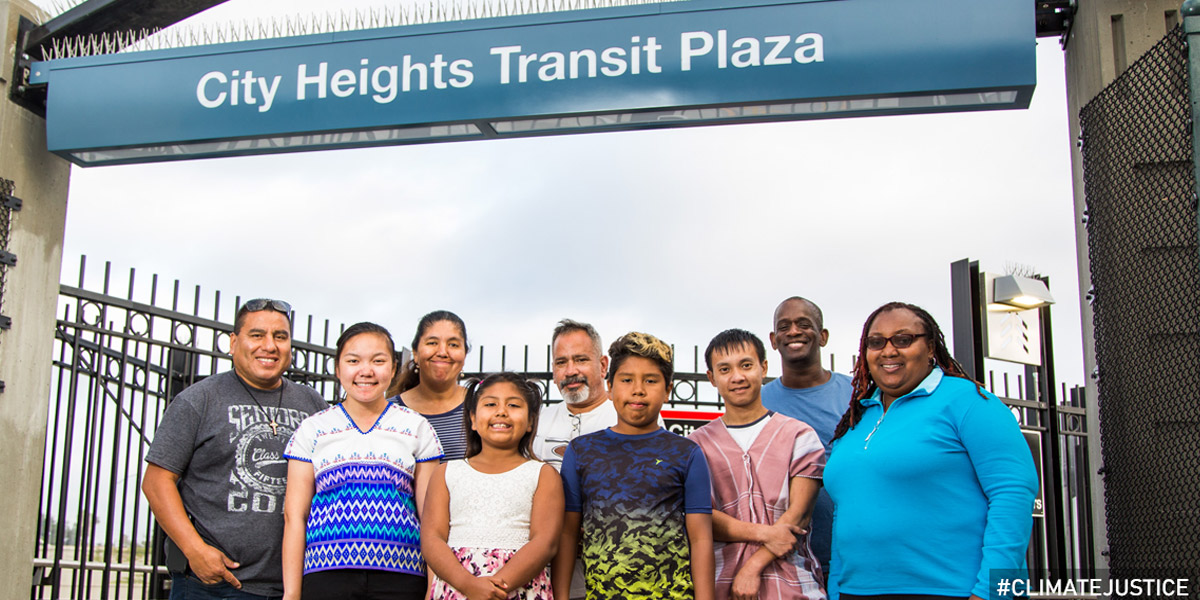
In April 2020, the MTS Board of Directors postponed Elevate SD 2020, a ballot measure that, if approved, would have raised $24 billion over the next 50 years. The initiative had the potential to transform San Diego’s transit system. EHC, community members, and partner organizations have all worked tirelessly for the past two years advocating for MTS to prioritize equity and environmental justice (EJ) communities as it shaped Elevate SD 2020.
Then our lives were completely upended by the COVID-19 pandemic. As transit ridership plummeted and unemployment skyrocketed, the likelihood of a successful ballot measure became dire. While the ballot measure will not move forward, EHC and the San Diego Transportation Equity Working Group (SDTEWG) will now work even harder to achieve our EJ priorities through different channels like the SANDAG regional transportation plan.
Our communities and our environment cannot afford “a return to normal.” We cannot afford to waste time and money by locking in decades of toxic pollution and greenhouse gas emissions, which will lead us into another health crisis from worsened air pollution and climate change.
Follow us on Facebook and Twitter to stay tuned for updates on our climate and transportation justice work as we continue to advance EJ priorities.
For more information about our Transportation Justice advocacy, contact Oscar Medina at Esta dirección de correo electrónico está siendo protegida contra los robots de spam. Necesita tener JavaScript habilitado para poder verlo.
Renters need clean energy too. In San Diego, non EJ communities have more than double the residential solar (40 per 1000 residents) compared to EJ communities (18 per 1000 residents). We attribute this discrepancy to a variety of barriers making solar installation difficult to access and afford for all people.
San Diego is a “solar star,” but not for environmental justice communities. According to a 2018 report by Environment California, San Diego has the second most solar power capacity among the 69 cities surveyed. Unfortunately, installed solar power does not extend to EJ communities.
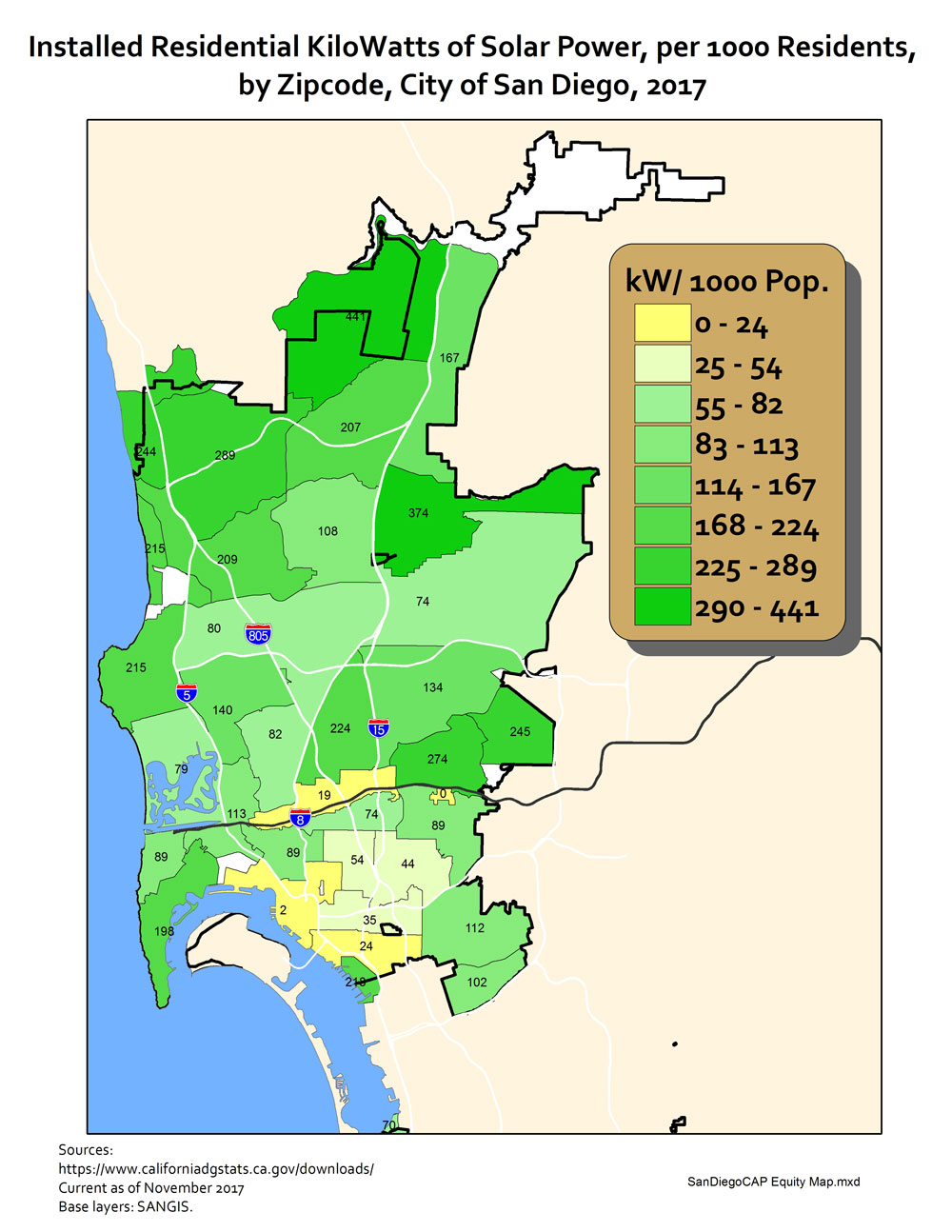 The map titled Installed Residential KiloWatts of Solar Power, per 1000 Residents, by Zipcode, City of San Diego, 2017 shows the geography of the number of kilowatts installed per 1,000 residents. The table titled Average Number of Solar Installations per 1000 people includes this metric and the average number of installations broken out by EJ communities, City, and non-EJ communities. Both statistics highlight that residential solar power installation in EJ communities is minimal.
The map titled Installed Residential KiloWatts of Solar Power, per 1000 Residents, by Zipcode, City of San Diego, 2017 shows the geography of the number of kilowatts installed per 1,000 residents. The table titled Average Number of Solar Installations per 1000 people includes this metric and the average number of installations broken out by EJ communities, City, and non-EJ communities. Both statistics highlight that residential solar power installation in EJ communities is minimal.
A study done by the California Energy Commission identified barriers and recommendations to bridge the clean energy gap for low-income customers and small business contracting opportunities in disadvantaged communities. The structural barriers identified include low home ownership rates, insufficient access to capital, and aged buildings. The report by the California Energy Commission is an excellent guide to inform the implementation of the San Diego CAP.
• Contact Caro Esta dirección de correo electrónico está siendo protegida contra los robots de spam. Necesita tener JavaScript habilitado para poder verlo. or call 619-474-0220 ext 131
• DONATE to EHC
Solar on Multifamily Affordable Housing (SOMAH)
In 2015, the California Environmental Justice Alliance together with the Center for Sustainable Energy, GRID Alternatives, and the Association for Energy Affordability, with the support of EJ allies like Environmental Health Coalition (EHC) secured passage of California Assembly Bill 693. This legislation created Solar on Multifamily Affordable Housing (SOMAH) program, which provides up to $1 billion to install solar in disadvantaged communities across the state. SOMAH is the largest investment in solar in the country, and the majority of bill savings and benefits will go to tenants while providing paid solar job training opportunities.
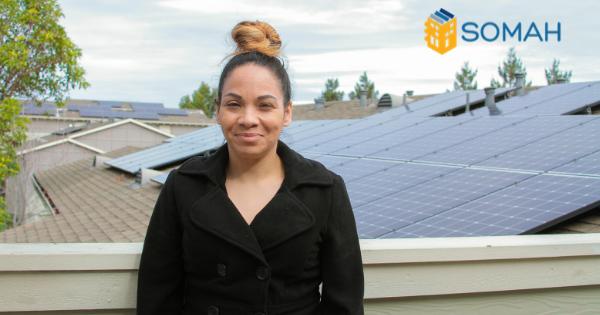
EHC will support SOMAH’s implementation through targeted outreach and engagement activities aimed at ensuring our EJ communities gain access to the full benefits of solar, including access to renewable energy, reduced utility bills, job training opportunities and economic development.
Are you a renter living in affordable housing? Do you want to help bring clean energy and jobs to your community? Here’s how you can learn more and get involved:
Thank you for signing up for our newsletter!
Environmental Health Coalition (EHC) works for environmental justice in the San Diego/Tijuana region and throughout California. Founded in 1980, EHC has worked to reduce pollution and improve health and well-being for thousands of people in underserved, low-income communities.
We believe that all people and communities have the right to live, work and play in a clean and safe environment regardless of their ZIP code.
EHC's local work supports residents in low-income, ethnically diverse communities including Barrio Logan, Sherman Heights, Logan Heights, City Heights, National City and Colonia Chilpancingo.
A common thread in all of EHC's campaigns is the recognition of the cumulative impacts of environmental, social, political and economic vulnerabilities that affect the quality of life in our communities.
We are committed to working with low-income communities and communities of color to:
Choose your curriculum
SALTA turns community members into local leaders with a nine-course training in community organizing, policy advocacy, community health, environmental justice and effective communication. Click here to download this free, online leadership-training curriculum in either English or Spanish.
View CurriculumCreating Healthy Neighborhoods is a free video guide and fun curriculum that uses real-life examples to show how everyday people can become advocates and activists for social and environmental justice. Click here for the free, online leadership-training tools to fight for justice with your community.
View CurriculumThank you for visiting the national resource for lead-free candy. We know you care about children's health, so we've developed resources to answer all your questions about keeping your children healthy and safe.

Environmental Health Coalition, the California Attorney General's Office and partners spearheaded the movement to eliminate lead in candy. After a thorough investigation, lawsuit and a statewide law, California now requires candy manufacturers operate within strict legal standards and undergo regular audits to ensure compliance. As a result, candy sold in stores today has been tested for lead levels and certified as lead free.
View a list of popular candies that are lead free.
If you are a candy manufacturer, click here.

What is lead?
Lead is a dangerous metal, harmful to developing brains and responsible for irreversible developmental problems. Lead is most commonly found in the lead-based paint and paint chips from homes built before 1979. Children may get sick by breathing or ingesting dust from this paint as it chips or deteriorates over time.
Most children with lead poisoning do not look or act sick, which is why it's important to get a blood-lead test every year until age six as their brains are developing during this period. Please explore our website to learn more about lead poisoning in children and read our frequently asked questions about lead-free candy to learn how to keep your family healthy and safe.
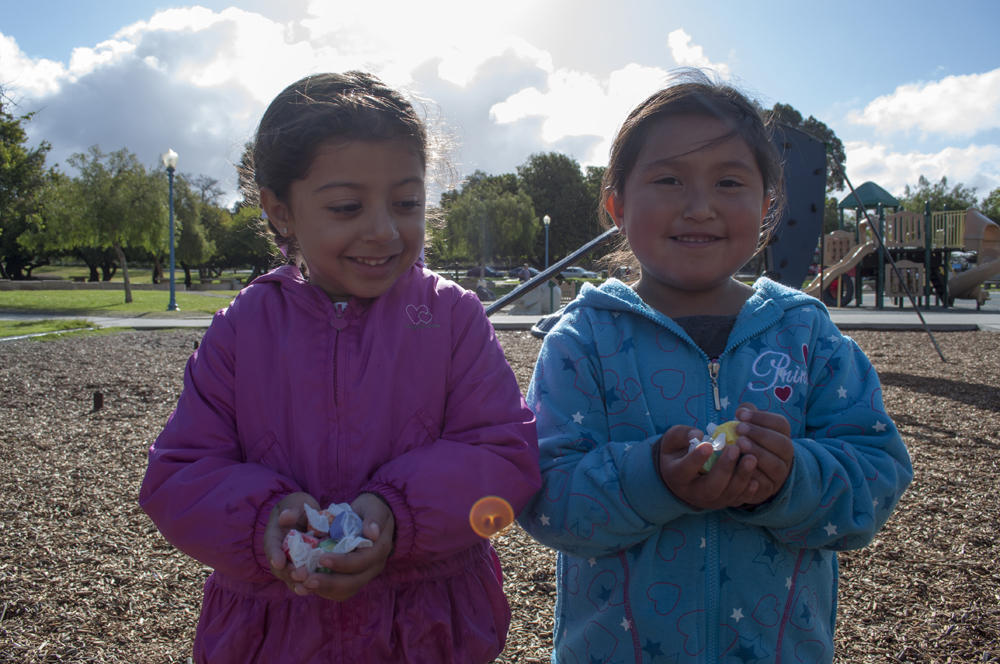 Lead-poisoning prevention is everyone's responsibility. Please join us in educating consumers, parents, teachers, school administrators, physicians and others about the hazards of lead in candies and proper precautions to avoid lead poisoning.
Lead-poisoning prevention is everyone's responsibility. Please join us in educating consumers, parents, teachers, school administrators, physicians and others about the hazards of lead in candies and proper precautions to avoid lead poisoning.
The following materials have been developed with the help of parents, health educators, community health workers and doctors. All materials can be copied and reproduced. Photographs may not be used outside of these materials.
For Consumers:
Frequently Asked Questions
Fact Sheet
For Manufacturers and Retailers:
Frequently Asked Questions
English information on state law compliance
Spanish information on state law compliance
Bliingual English/Spanish lead-free resources and auditor information
Bilingual English/Spanish window sticker
For Physicians and Healthcare Providers:
NEW: Proposed standard for naturally ocurring levels of lead in candy announced by California Office of Environmental Health Hazard Assessment (OEHHA):
If you manufacture or sell candy, please review the following important information.
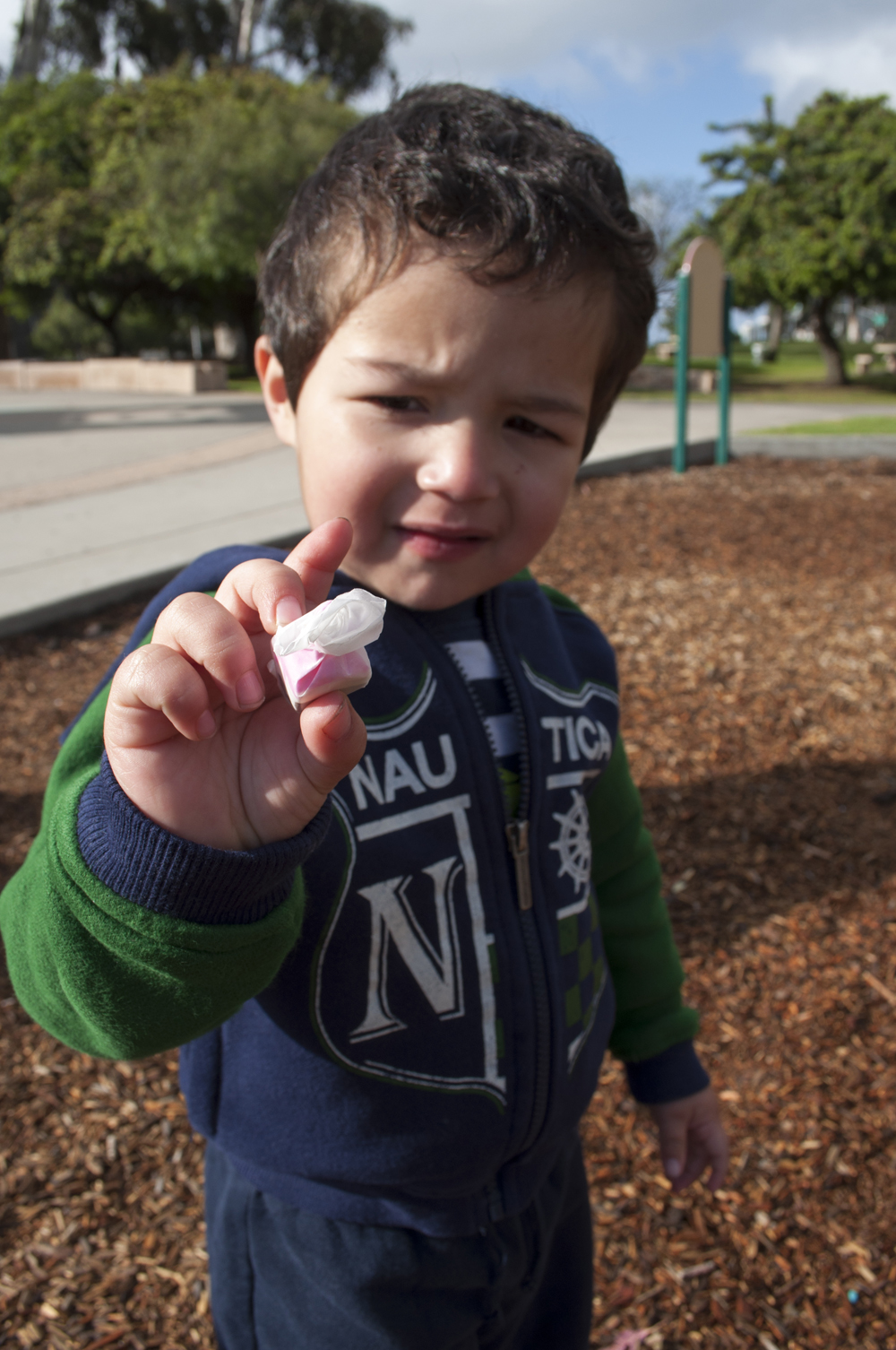
Facts about candy with lead
What to do if you sell candy
What to do if you manufacture candy
What to do if you manufacture candy:
Environmental Justice is the right of all people and communities to live, work, and play in a clean and safe environment.
Environmental Health Coalition fights against environmental racism which is defined as: policies and activities of governments, corporations, educational institutions or other large organizations with the power to influence many people that, either intentionally or unintentionally, result in people of color and/or low income people being exposed to greater environmental hazards.
In San Diego County, the relationship between race, income and pollution is quite clear as illustrated by this map that shows the greatest concentrations of people of color and low income people overlaid with facilities that emit air pollution (red dots) and facilities that utilize toxic chemicals or generate hazardous waste.
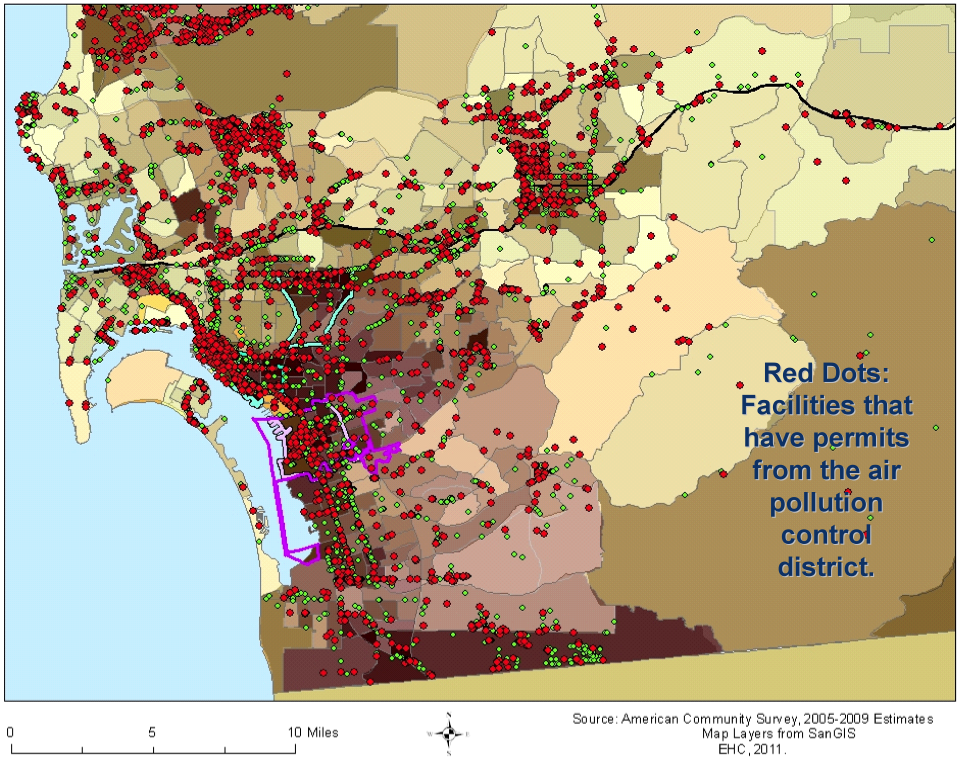
| Area | People of Color | Families in Poverty | Toxic Substances in Community |
| Barrio Logan | 97% | 35% | 127,908,799 pounds |
| La Jolla | 14% | 3% | 3,203,992 pounds |
California Environmental Justice Alliance
EHC is a founding member of the California Environmental Justice Alliance (CEJA), a statewide coalition of grassroots, environmental justice organizations. We are working to achieve environmental justice by organizing in low-income communities and communities of color – those most impacted by environmental hazards – and by pushing for policies at the federal, state, regional and local levels that protect public health and the environment.
CEJA unites the powerful local organizing efforts of members to create comprehensive opportunities for change at a statewide level. We combine grassroots organizing with strategic policy advocacy. Visit CEJA's website.
Building Healthy Communities from the Ground Up: Environmental Justice in California
Every day, California's low-income communities and communities of color face challenges from a disproportionate burden of toxics and pollution. Unequal political and legal rights worsen these conditions, due to a lack of community resources and exclusion of affected communities from public policy-making.
Building Healthy Communities from the Ground Up is an early publication of the California Environmental Justice Alliance which provide policy recommendations to build healthy communities and achieve environmental justice in California. Download the report.
Justice in the Air: Tracking Toxic Pollution from America's Industries and Companies to Our States, Cities, and Neighborhoods
By Michael Ash, James K. Boyce, Grace Chang, Manuel Pastor, Justin Scoggins, and Jennifer Tran[Ash, Boyce, and Chang are from the Political Economy Research Institute (PERI) at the University of Massachusetts, Amherst; Pastor, Scoggins, and Tran are from the Program for Environmental and Regional Equity (PERE) at the University of Southern California]
April 2009
With climate change threatening our way of life, dirty air triggering asthma, and industrial pollutants causing cancer, the nation is more motivated than ever before to take a hard look at the problems we face and seek new approaches that can better secure the future of the planet and save lives.
This study is one of the first to track, which states and metropolitan areas have the biggest gap between the health risk from toxic pollution faced by people of color and the poor compared to their proportion of the population. The results confirm what many Americans of color and low-income Americans have known for a long time: clean air is not necessarily an equal opportunity affair. Download the report.
The Climate Gap: Inequalities in How Climate Change Hurts Americans & How to Close the Gap
By Rachel Morello Frosch, Manuel Pastor, Jim Sadd, and Seth Shonkoff
May 2009
By now, virtually all Americans concur that climate change is real, and could pose devastating consequences for our nation and our children. Equally real is the "Climate Gap" – the sometimes hidden and often-unequal impact climate change will have on people of color and the poor in the United States. Download the report.
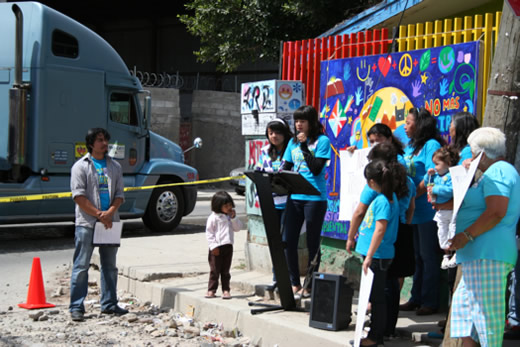 Misión
MisiónLa Environmental Health Coalition está dedicada a lograr la justicia ambiental y social. Creemos que la justicia se logra cuando las comunidades empoderadas actúan juntas para lograr el cambio social. Organizamos y abogamos para proteger la salud pública y el medio ambiente amenazados por la contaminación tóxica. La EHC apoya amplios esfuerzos para crear un sociedad justa que fomente una calidad de vida saludable y sostenible.
Justicia | eliminar la injusticia social y ambiental
Salud | eliminar la degradación al medio ambiente y a la salud pública causada por la contaminación tóxica
Medio Ambiente | conservar y proteger la integridad del ecosistema
Prevención | establecer el principio precautorio y la prevención de la contaminación como la base de todas las políticas ambientales y de salud pública
Gobierno | asegurar una amplia intervención gubernamental para la protección de los derechos humanos y ambientales
Responsabilidad Corporativa | establecer mandatos para responsabilizar a las corporaciones por acciones que afecten al público
Organización | fortalecer y mantener una organización fuerte, eficaz y sostenible basada en el respeto, integridad, participación democrática en la toma de decisiones y en principios éticos
Base | crear relaciones fuertes y autenticas, y desarrollar liderazgo entre individuos y organizaciones que comparten la ideología y metas de la EHC
Aliados | trabajar de manera cooperativa para formar alianzas eficaces de justicia social a nivel local, estatal, nacional e internacional
Empoderamiento | empoderar a individuos con la habilidad y autoridad de lograr la autodeterminación para sí mismos, sus familias y sus comunidades
La EHC pone en practica su misión y metas por medio de campañas de base comunitaria para enfrentar las injustas consecuencias de la contaminación tóxica, uso de suelo discriminatorio y políticas de energía no sostenible. La EHC empodera a los residentes por medio del desarrollo de líderes, organización y abogacía, para que logren políticas públicas que mejoren la salud de los niños, familias y barrios, y al medio ambiente natural en la región de San Diego/Tijuana.
(Para ampliar haga clic en la imagen)
Oficialmente fundamos la Environmental Health Coalition en 1980 como la Coalition Against Cancer. En ese entonces, aumentó rápidamente nuestro conocimiento acerca de la conexión entre serios efectos a la salud y los productos químicos utilizados en nuestros hogares y lugares de trabajo que a menudo se desechaban en nuestros barrios.
Ahora 30 años después, la Environmental Health Coalition se ha convertido en un líder en el movimiento de justicia ambiental y un recurso para organizaciones de base comunitaria que trabajan en los campos de salud ambiental, justicia ambiental y social, derechos humanos y en la sostenibilidad medioambiental
Nuestras estrategias de punta han sido clave en nuestros primeros logros, incluyendo:
La EHC, una de las organizaciones de base con más experiencia en los Estados Unidos, emplea estrategias eficaces de cambio social para lograr la justicia ambiental.
Nuestra fuerza se debe a nuestros talentosos, dedicados y persistentes equipo de personal y mesa directiva, quienes brindan una diversidad de habilidad y experiencia, y a nuestros líderes que forman parte de nuestros cinco Equipos de Acción Comunitaria de las comunidades en las que más trabajamos.
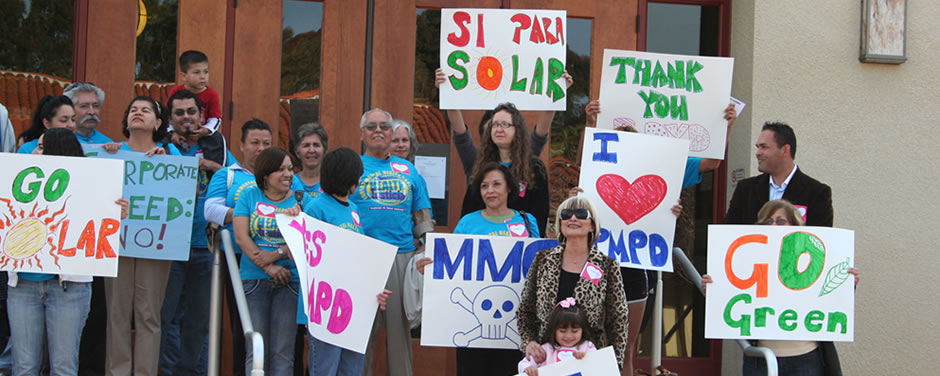
La Environmental Health Coalition se comprometió a un intensivo proceso de planeación estratégica con su equipo de personal, mesa directiva y lideres comunitarios que resultó en una visión de diez años.
Aumentando el Poder para Ganar: Visión Estratégica 2008-2018, es un plan que proporciona un resumen de las victorias principales de la EHC y presenta nuestros métodos de organización comunitaria, abogacía de política, empoderamiento de líder y sostenibilidad organizacional.
Las dinámicas de la pobreza, racismo institucionalizado y políticas gubernamentales inadecuadas se ínter cruzan y aumentan la gravedad de estos problemas en nuestras comunidades. La falta del poder y recursos presentan retos para involucrarse en la toma de decisiones de política pública. La EHC se ha enfrentado a estos retos una y otra vez aumentando el poder comunitario y organizacional.
El poder comunitario resulta del empoderamiento que habilita y proporciona recursos e información a la gente afectada para lograr la justicia en sus comunidades. El poder organizacional proviene de nuestros talentosos, dedicados y persistentes equipo de personal y mesa directiva, que brindan una diversidad de habilidad y experiencia.
El poder también requiere de recursos-el financiamiento es fundamental. Desde la contribución de $5 dólares a la beca de $50,000 dólares cada uno de estos se gasta de manera eficiente para mejorar vidas y apreciamos profundamente el apoyo.
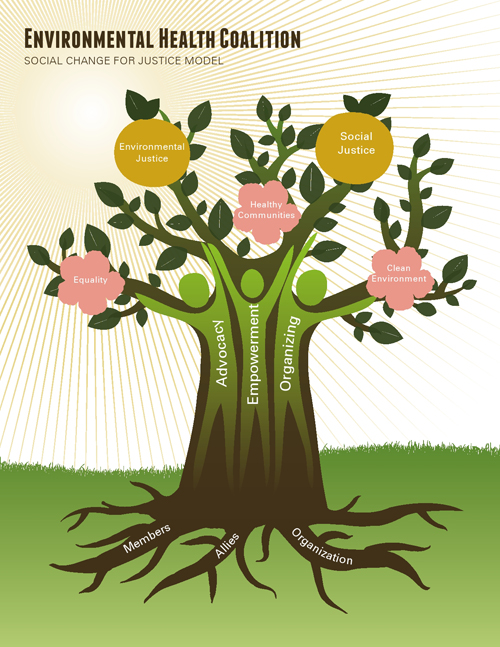 Social Change for Justice Model (SCFJ) is a framework integrating EHC's ideology and strategies to increase our ability to achieve social and environmental justice goals. The model incorporates all aspects of the EHC structure and method of work recognizing the critical importance and integration of our three core strategies: community organizing, policy advocacy and leader empowerment.
Social Change for Justice Model (SCFJ) is a framework integrating EHC's ideology and strategies to increase our ability to achieve social and environmental justice goals. The model incorporates all aspects of the EHC structure and method of work recognizing the critical importance and integration of our three core strategies: community organizing, policy advocacy and leader empowerment.
After over 30 years, we know a lot about what works and what doesn't. We know that we have a much better chance of accomplishing our goals by using a strategic, disciplined and deliberate approach. The model enhances the ability of EHC staff and community leaders to work effectively by increasing the consciousness with which the work is conducted and by providing clear guidance for how to do it.
The EHC Social Change for Justice Model guidance includes:
Organizing, advocacy and leader empowerment are fundamental to the work of many social justice organizations and change models. EHC has found that recognizing the unique nature and requirements of each strategy and intentionally integrating them results in stronger and more effective campaign outcomes.
EHC defines community organizing as "a values-based strategy that educates and empowers people to take action to win real improvements in their lives for the benefit of their communities and the common good."
The three major base-building tactics of organizing are:
Building -- Identifying and involving individuals who believe in EHC's Mission and Goals and who want to work to achieve specific changes in their communities
Mobilizing -- Activating members to take specific actions in order to demonstrate broad and deep support for EHC efforts
Maintaining -- Increasing participation, deepening commitment and expanding political consciousness of EHC members
EHC defines policy advocacy as "a values-based strategy that represents, champions and defends the public's interest and affected communities."
EHC advocacy efforts follow a Problem-Solution-Action flow described as:
Problem -- Conducting issue research and power analysis to understand the conditions and identify the injustice
Solution – Determining the best and most winnable solution to reach the desired goal
Action – Implementing a strategic plan with clear goals, objectives, tactics and targets
Since EHC's work supports our community base, leadership development is critical to achieving success. As EHC members become more deeply involved, they are invited to participate in EHC's signature leadership training, SALTA (Salud Ambiental Líderes Tomando Acción - Environmental Health, Leaders Taking Action). SALTA provides skills training on organizing, advocacy, power, and communications and educates about environmental health and justice issues.
Leaders who have completed SALTA are invited to become members of one of EHC's Community Action Teams (CAT). These teams are established in every EHC target community. CAT members are EHC leaders who guide the development and implementation of strategy for each campaign, program and effort. Some CAT members then join the EHC board of directors to guide the organization's vision and direction. Approximately 50% of board members are CAT members.
Completely reintermediate emerging products whereas B2C scenarios. Continually engage principle-centered innovation vis-a-vis leveraged leadership skills. Collaboratively engineer enabled niche markets via granular internal or "organic" sources. Proactively visualize empowered benefits vis-a-vis cost effective best practices.
Nuestra fuerza se debe a nuestros talentosos, dedicados y persistentes equipo de personal y mesa directiva, quienes brindan una diversidad de habilidad y experiencia, y a nuestros lideres que forman parte de nuestros cinco Equipos de Acción Comunitaria de las comunidades en las que más trabajamos.